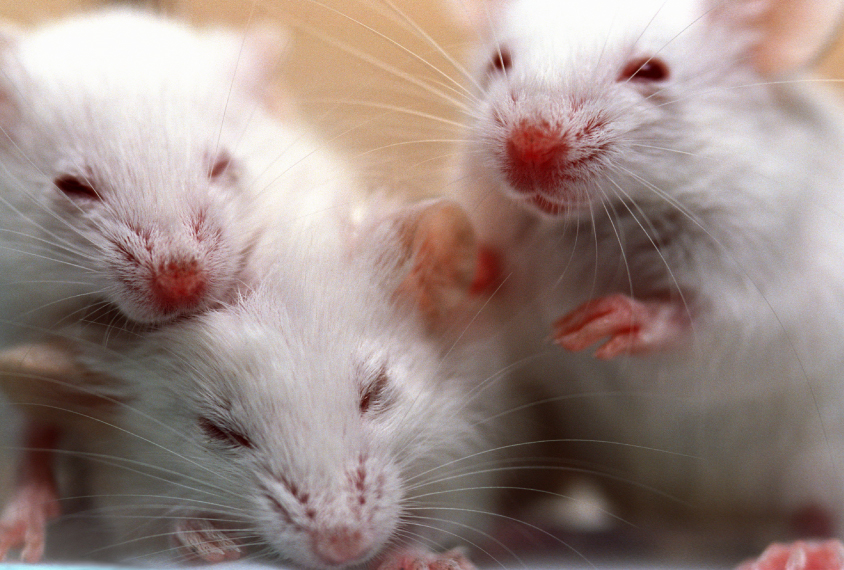
Heidi and Hans-Juergen Koch / Minden Pictures
THIS ARTICLE IS MORE THAN FIVE YEARS OLD
This article is more than five years old. Autism research — and science in general — is constantly evolving, so older articles may contain information or theories that have been reevaluated since their original publication date.
Mice missing FMR1, the gene mutated in fragile X syndrome, have an atypical brain response to meeting an unfamiliar mouse1.
The mice show increased activity in the amygdala, a brain region that regulates fear and anxiety, compared with control mice. They also show altered patterns of gene expression in the amygdala and the prefrontal cortex, a brain region involved in social behavior and decision-making. Genes that interact with FMR1 or have ties to autism are overrepresented among those with altered expression.
Fragile X syndrome is the most common inherited form of intellectual disability. Up to two-thirds of people with the syndrome also have autism. Mice missing FMR1 recapitulate some features of the syndrome, but studies of social behavior in the mice have yielded inconsistent results.
The new study bypasses behavior, focusing instead on the brain’s response to a social stimulus.
“We can use social experience as a probe, really, for what might be relevant to the social symptoms in autism spectrum disorders at a molecular level,” says lead investigator Jeremy Veenstra-VanderWeele, professor of psychiatry at Columbia University.
The work suggests that interactions among networks of genes play an important role in social behaviors.
“This is one of the few studies to investigate a mouse model of a neurodevelopmental disorder with the same level of genetic sophistication as used in [similar] human studies,” says Jacqueline Crawley, professor of psychiatry and behavioral sciences at the University of California, Davis. Crawley was not involved in the study but oversaw peer review for this paper.
Social experiment:
The researchers exposed mice missing FMR1 to an overturned wire cup containing either an unfamiliar mouse or a small toy horse. Each mouse spent 30 minutes with the mouse or the toy.
Two hours later, the researchers inspected brain tissue from the mice. They stained the tissue for c-FOS, a protein transiently expressed in neurons shortly after they are activated.
They found that, as in controls, the fragile X mice show stronger c-FOS staining in the amygdala — and in more cells — when exposed to the unfamiliar mouse than to the toy horse. The c-FOS signal was strongest in the fragile X mice. The findings were published 23 June in Molecular Autism.
The researchers repeated the experiment in a second set of mice, but this time they collected the brain tissue 10 hours later. They extracted RNA — the intermediate between DNA and protein — from the amygdala and prefrontal cortex to analyze gene expression patterns.
Some genes in the amygdala and the prefrontal cortex of the fragile X mice show a different pattern of expression when exposed to another mouse than do those of controls. This set of genes is not the same as the one altered in the mutant mice when exposed to a toy.
A disproportionate number of the genes altered in response to social stimulus are regulated by FMR1 or are implicated in autism. For example, in the lateral amygdala, 11 of the 527 genes are related to autism; fewer than four would be expected to be related to autism by chance.
Big picture:
The study is too small to draw conclusions about the role of any specific gene in social behavior. But it highlights a novel way to explore the molecular basis of social problems, experts say.
“Behavior can often be messy — that’s why different labs find different things,” says Larry Young, chief of behavioral neuroscience and psychiatric disorders at Emory University in Atlanta, who was not involved in the work. “The nice thing about this is that it is homing in on brain activation.”
Scientists could track changes in gene expression in fragile X mice at different time points after the social stimulus, and across multiple brain regions known to process social information, Young says. “Then you might get a bigger picture of how the [FMR1] mutation influences the flow of information throughout the brain,” he says.
The researchers plan to repeat their experiment in other mouse models of autism. Similarities across mouse models may reveal brain regions and gene networks relevant to social function.
By joining the discussion, you agree to our privacy policy.